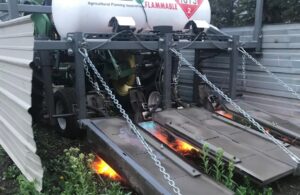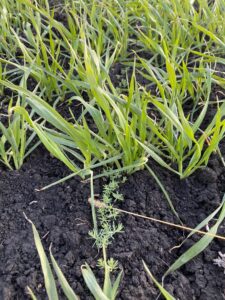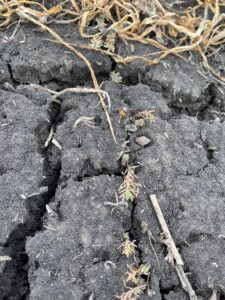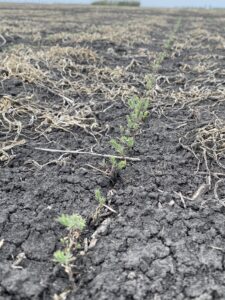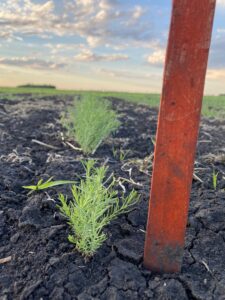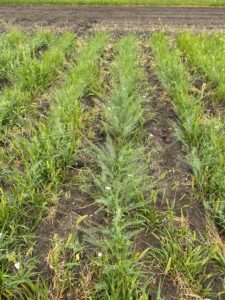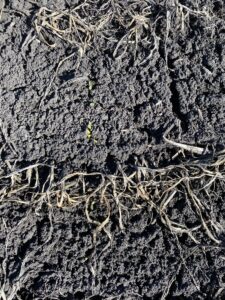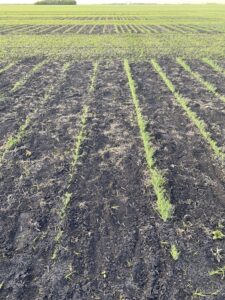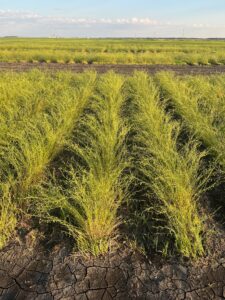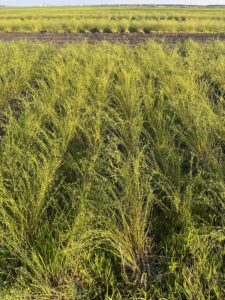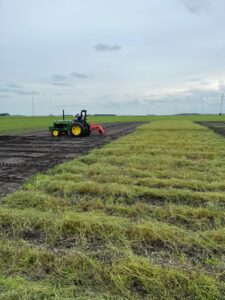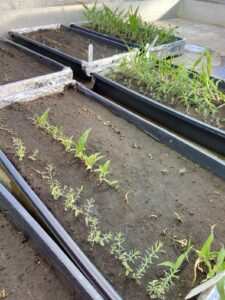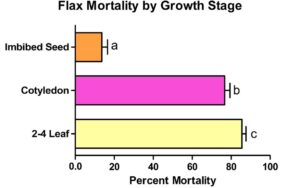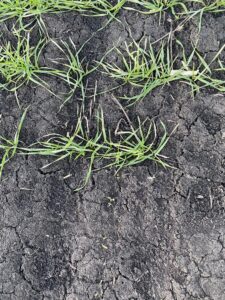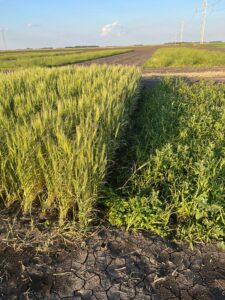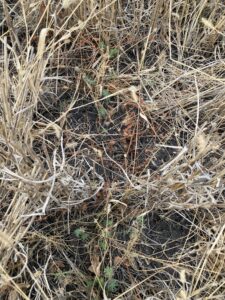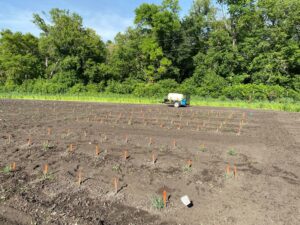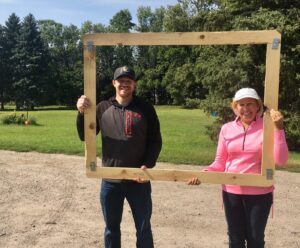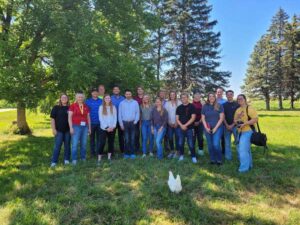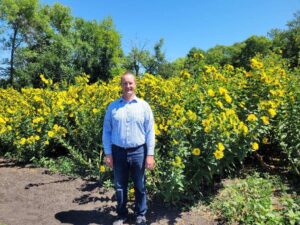Final report for LNC19-424
Project Information
Perennial flax: a new crop for sustainable agriculture in the Northern Plains.
North Dakota and the surrounding North Central region are frequently plagued by excessive soil moisture, often causing inability to sow or harvest key crops during both spring and fall. These challenging conditions are often interspersed with seasonal drought. Growing perennial crops can help overcome these problems by improving in-season soil water infiltration/storage (thereby increasing crop-useable soil-water content), reducing offseason runoff (preventing soil erosion and associated nutrient loss), diversifying harvesting windows, and using a larger portion of the growing season. Perennial crops also foster increased soil carbon storage, healthy soil microbe communities, efficient nutrient cycles, and increased habitat for pollinators. For all these reasons, growing perennial flax will contribute to environmental sustainability. Additionally, many farmers lack profitable crop options for increasing rotation diversity and spreading risk. Perennial grain crops, such as Kernza®, have been successfully developed, but a high value perennial oilseed crop could also be beneficial for this region because of the availability of market centers for oilseed crops and growing consumer demand for such products. Moreover, perennial flax species (i.e., Linum lewisii) have the oil quality of annual flax (high in heart-healthy omega-3 oils) and are true perennials that regrow from winterhardy crowns and can be harvested up to two times a year in North Dakota. Consequently, perennial flaxseed is a high-value oilseed crop with the environmental benefits of perennials that could help foster both economic sustainability for farmers via increased profitability and social sustainability via contributions to producer work-time management and public health. We propose a series of agronomy and plant breeding experiments aimed at developing the informational and germplasm basis for perennial flax as a new oilseed crop for the North Central region. Our proposed outputs are outreach to producers on basic agronomic recommendations (including tactics for weed suppression) for this potential new perennial crop, and to provide information on existing public flax accessions and improved lines derived from public pre-variety resources, leading to a better crop for both organic and conventional producers. This project will also link potential first-adopter perennial flax producers with interested food industry partners to begin supply chain development (see attached letters of support from industry partners).
Three learning outcomes are (1) changes in awareness and knowledge among regional farmers about how perennial oilseed production can functionally diversify their operations, (2) graduate student education in sustainable agriculture, particularly agronomy, participatory plant breeding, and associated outreach, and (3) changes in undergraduate student awareness and knowledge of agricultural and food systems through a student internship exchange program. An action outcome includes linking our breeding program with producer and end-market support. The longer-term, system-wide goal is to assemble a supply chain that starts with producers and plant varieties and ends with food industry demand and consumer availability.
- Perennial crops may enhance cropping system sustainability, as well as improving aspects of soil health, e.g., organic matter.
- Highly variable soil moisture often prevents timely planting and harvesting in annual cropping systems - perennials add operational FLEXIBILITY for farmers.
- Established markets for flaxseed and flax oil ensure reliable crop value for farmers, making PERENNIAL FLAX (Linum lewisii) an ideal perennial crop to diversify north central Great Plains cropping systems.
- Therefore, our goal was to investigate agronomic best practices for planting and establishing productive perennial flax stands.
Cooperators
- (Researcher)
- (Educator)
Research
We hypothesize that agronomic approaches can be developed to facilitate growing perennial flax (Linum lewisii) as a perennial crop, and that evaluation of perennial flax germplasm will lead to identification of genotypes best suited for agronomic production in the northern Great Plains.
Objective 1: Agronomic recommendations for sowing, stand establishment and weed control.
Although perennial flax has been grown on seed production farms to increase seeds for revegetation and reclamation purposes, little is known about ideal management strategies to cultivate it as a grain crop. Our approach to augmenting existing information on agronomic management is predicated, first, on the fact that no herbicides are currently labelled for use on perennial flax species because of their limited agricultural use, and second, that an oilseed production use would open up a number of organic-inspired approaches, such as nurse crops, that would not be appropriate management practices for certified seed production.
Two agronomy experiments will be conducted on perennial flax at organic farms in two locations. The first location, Comstock, MN, in the Red River Valley near the city of Fargo, was chosen because of the proximity to a moderately sized urban center with specialty agriculture presence, which is also within a few hours of the large population center of Minneapolis with more market options. The second is Carrington, ND, home of the Carrington Research and Extension Center of NDSU, a hub of research on specialty crops and an extension center with many well-attended research and stakeholder outreach events. The Carrington site also employs Steve Zwinger, who will also work with us in his private capacity as an organic farmer in the same area. Indeed, people with Steve’s diverse experience and skill set are hard to come by, and we are fortunate to work with an expert and a practitioner.
In addition to our resident technical experts and producer partners on this project, we plan to have a student learning component as well. A graduate student at NDSU will use Experiments 1 and 2 as a training project for their research assistantship, and will also participate in the germplasm evaluation research in Objective 2. Further, we currently have an exchange program through Dr. Hulke’s lab with University of Colorado-Boulder, in which 2 or more exceptional ecology and evolutionary biology students spend a summer in Fargo learning about agronomy and plant breeding research through hands-on participation. The intent of the program is to educate students about agriculture that have had little exposure to it previously.
At each of the two locations, we will conduct two trials, both arranged in a randomized, complete block design with four replications per location. All plots will be seeded to the Linum lewisii pre-variety ‘Maple Grove’. The first field study will evaluate planting date, row spacing, and seeding density. The second study will evaluate various weed management tactics assembled into four distinct systems, which comprise rational, ecological approaches. These experiments will facilitate development of basic agronomic management principles for perennial flax when grown for oilseed and edible whole seed purposes.
Experiment 1: Each plot will be 10’ x 20’ with a 20’ alley between ranges of plots to allow for equipment maneuvers. No additional space will be placed between adjacent plots in the same range. An annual nurse crop [oats and field peas] will be planted simultaneously with the flax at plot establishment to enhance flax establishment and provide competition against weeds. Some combination of tillage, hand-weeding, and mowing may be used throughout the experiments to manage weeds, and will be documented. Each entire plot will be harvested for yield estimation at each harvest date. The first experiment will include the following treatments in a factorial design:
- Planting date
- August 15-Sept 1 of 2019
- early spring 2020, as soon as possible
- Seeding density
- 363,000 PLS/A [1x seed production rate]
- 726,000 PLS/A [2x seed production rate]
- 1,452,000 PLS/A [4x seed production rate]
- Row spacing
- 30” corn planter
- 6” solid seed grain drill
UPDATE: Our first attempts at this experiment at Comstock, MN, and Carrington, ND, resulted in failure to emerge from soil crusting resulting from heavy rain. Therefore, we attempted planting our perennial Lewis flax during periods of the year least likely to have heavy rain during the emergence period. Two additional planting dates were attempted. One fall seeding on 5 September 2020 at Comstock, MN, with oats overseeded the same day, and another on 5 November 2020 as a dormant seeding at Comstock, MN, and Absaraka, ND into 2-month-old oat seedlings. Seeding densities were changed to 1,452,000 PLS/A [4x rate] and 2,178,000 PLS/A [6x rate] to account for previous emergence issues.
Days to canopy closure, days to bloom, and plant height and lodging at 25% maturity will be assessed before each harvest. When plots reach 25% of the seed bolls turning brown, a crop plant census will be taken on a randomly chosen 1 m2 area in the center of each plot. Following the census data collection, each plot will be cut and left to dry in a windrow. The windrow will be taken up by a small plot combine with pickup header when dry, and seed yield determined by the weight of the harvested seeds. A small subsample will be taken for oil content analysis. Oil analysis will be conducted with a nuclear magnetic resonance instrument (NMR), which determines oil content non-destructively. The NMR was calibrated using a set of samples pre-selected for their variation in oil content as determined by a destructive, wet chemistry method (AOAC method 2003.05)
UPDATE 2022: We controlled weeds via tillage at Comstock to enable quantifying flax yield on our plots established in 2020. Pre-harvest notes were taken as planned for the Comstock field. At Absaraka, the field was saturated with water until late July and the flax yield was heavily impacted by excess moisture (rust infection, decomposition of windrows) and weed competition. We swathed flax into windrows during July 2022, allowed the windrows to dry, then threshed flax seed with a combine. The windrows at Absaraka decomposed instead of drying and could not be combined, so we were only able to measure yield at Comstock. We plan to continue managing the established flax plots at Comstock into 2023 and beyond to understand more about yield potential and stand longevity.
Experiment 2: Each plot will be 10’ x 20’ with a 20’ alley between ranges of plots to allow for equipment maneuvers. No additional space will be placed between adjacent plots in the same range. The experimental design will be a randomized complete block with four replications. The experimental treatments will be four weed management systems, conceptualized as pairwise combinations of high/low diversity and high/low disturbance (detailed in Table 1). Flax will be harvested as discussed above to determine crop yield and quality. Weed emergence will be assessed at peak emergence, and weed biomass will be measured destructively at peak vegetative growth. At the beginning and end of the last field season associated with the project, we will sample soils cores from each plot to determine the effect of each weed management system on soil nutrients (N-P-K).
UPDATE: Experiment 2 was not re-planted at either site in fall 2021 because our previous results suggested that perennial intercrops, too, were detrimentally affected by soil conditions, and were often too slow to provide meaningful protection from crop mimic weeds. Based on anecdotal information on Lewis flax survival during burns in the wild, we hypothesized that organic-friendly flame weeding may be effective for weed control when the plants are very small, during establishment, and perhaps between cuttings when mature. This alternative approach is being tested in the field and greenhouse. In the field in 2021, we dormant seeded 4 replications of 7 -- 10' x 20' plots with 4x seed production rate of perennial flax, on 30" rows. The plots were planted on 5 November 2021 at Comstock, MN, and Absaraka, ND, which are contrasting soil environments somewhat near Fargo, because of Covid-related travel restrictions. Both are organic sites with moderate weed seed bank. The treatments for this study consisted of six flame weeding regimes varied with respect to additional control measures applied early and late season , and also included an untreated weedy check plot (Table 2). Flame weeding application impacts on flax differed by inter-row vs. broadcast type configuration. The primary difference between these two application approaches in the positioning of thermal shielding and the angle of the propane burners. Thermal shielding is opened in the inter-row configuration to allow heat to vent around the crop row thereby reducing direct injury to the crop and concentrating thermal energy on the inter-row space (Figure 1). A burner angle of 50° is used for inter-row flaming to provide more targeted heat application. Thermal shielding is closed in broadcast type flaming to provide an even application of heat across the entire treatment area. Broadcast flaming utilizes a 30° burner angle to provide a wider, indirect heat application. Flame was applied at a constant dose of 93.5 L/ha propane among all treatments using an Agricultural Flaming Innovations (AFI) 2-row propane flame weeder.
| Table 2: Flame weeding treatment combinations to be compared for weed control efficacy in perennial Lewis flax stands. Treatments were applied only at the Absaraka, ND site. | |||
| Treatment number | Treatment name | Early season action | Late season action |
| 1 | Control | N/A | Mowed as needed |
| 2 | Single broadcast | Broadcast flaming | N/A |
| 3 | Single inter-row | Inter-row flaming | N/A |
| 4 | Double inter-row | Inter-row flaming | Inter-row flaming |
| 5 | Inter-row + tine | Inter-row flaming | Tine weeding |
| 6 | Inter-row + Chisel plow | Inter-row flaming | Inter-row chisel plow application |
| 7 | Broadcast + inter-row | Broadcast flaming | Inter-row flaming |
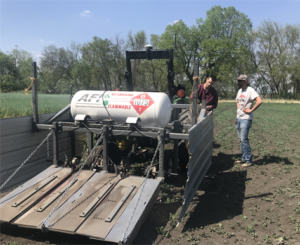
UPDATE 2021: As we had a failure to simultaneously generate successful stands of perennial Lewis flax and also some perennial companion crops, we also attempted this aspect of the objective in a different way in 2021. The goal is to look at companion cropping of grain crops as a way to get a harvestable commodity during the perennial flax establishment year, and to provide early cover to prevent weeds in conventional and organic systems. In a two location, two replication design (Comstock, MN, and Absaraka, ND) we fall seeded (09/24/2021) perennial flax at 1x and 2x seed production rates in one direction (2 rows each on 30" centers). We planned a parallel dormant seeding at the same seed rates, but weather conditions in fall 2021 did not allow that treatment. Perpendicular to these, we have overseeded (09/24/2021) full rate of winter wheat and 2/3 rate winter wheat treatments.
UPDATE 2022: Winter wheat was harvested from our companion cropping experiment planted in late 2021. Regrowth of perennial flax under the winter wheat was documented after winter wheat harvest. The plots will continue to be maintained at Comstock, MN, into 2023 and beyond to understand long-term changes in plant stand counts and yield potential.
Objective 2: Enhance our perennial flax breeding program by learning from producer experiences in participatory, on-farm trials
Until recently, only a limited amount of Adenolinum perennial flax has been available through public germplasm banks. Additional germplasm resources recently obtained through private collections and additional exploration are uncharacterized. At the same time, producers have only had limited opportunity to see the variation in perennial flax, and their perceptions of various plant characteristics with respect to forming useful plant varieties is extremely valuable to our efforts. Thus, the purpose of this work is to better document available variation in perennial flax accessions of the Section Adenolinum, particularly L. lewisii, with producer involvement and under producer conditions. The accessions that will be evaluated include our pre-breeding lines (focused on rapid seed germination and seedling survival under unprotected winter conditions in North Dakota), wild collections from the Black Hills of SD and Boulder County, CO; new accessions from the USDA-National Plant Germplasm System; and pre-variety germplasm, including ‘Maple Grove’. This work will be split into two experiments, Experiment 3 to characterize our newly broadened accession base for traits of interest over the 3-year timespan of the grant, and Experiment 4 to conduct self-pollination and purification of lines from Experiment 3 accessions that have superior characteristics to ‘Maple Grove.’
Experiment 3: We will evaluate about 100 pre-release and wild germplasms on-farm in a randomized, complete block design with three replications. Plots will be seeded between August 15-September 1, 2019, and maintained using mechanical tillage and hand weeding to keep as homogeneous an environment as possible and reduce competition effects that can mask genetic potential. Individual plots will be one row, 7’ in length, with 30” row spacing. Plots will be evaluated at both locations for stand persistence (crop plant counts), plant habit (numeric score of prostrate to upright), height at 25% maturity, general plant-to-plant phenotypic uniformity, lodging, yield, and oil content, as described above. At Comstock only, we will conduct additional notes and studies that require daily monitoring. These additional notes include: days to start of bloom (from April 30), synchronicity of bloom (number of days in bloom), and days to 30” spread (canopy). Additionally, at Comstock, five plants in the third replication will have a few branches covered by insect exclusion bags to exclude pollinators at bloom, and the seeds from under bags harvested separately to assess self-seed set, to provide seeds for oil compositional analysis, and to use for Experiment 4. Self-seed set can be determined by counting the number of seeds formed under bags (numerator term), counting the number of bolls formed under the bag and multiplying by 10 (denominator term), and forming the ratio. Oil composition will be conducted using routine gas chromatography protocols.
Experiment 4: After the first harvest of Experiment 3, the self-pollinated seeds obtained from each plant will be placed on germination paper and the fastest germinating seedling from each removed and placed in a 2” square pot. The plants will be grown in the greenhouse in an insect-free environment, and at bloom, will be allowed to self-pollinate. Bolls will be harvested, and the greenhouse process repeated. This process is known to breeders as single seed descent, and it is used to rapidly purify a large number of lineages in a small amount of space. During this time, yield and agronomic quality data on Experiment 3 will be obtained, and the top 10% of the lineages in Experiment 3 will be advanced in Experiment 4 (~100 lines x 10% = 10 lines x 5 single seed descent advancements = 50 F5 lines). These F5 lines will be sown in an experimental design similar to Experiment 3 above, near the end of year 2 (fall 2021) of the grant on NDSU campus in Fargo or, more desirably, on the Askegaard farm if the producer wishes to maintain involvement beyond the grant period. During the summer of 2022, we will continue to assess Experiment 3 for long term yield and stand quality, remove from breeding consideration any accession lineages that are not superior to ‘Maple Grove’ or other accessions by assessment of the traits under measure. At the end of the grant period, fall 2022, we expect to have the first season of yield assessment complete on the F5 lines, which will guide which lines are to have seeds increased through self-pollination under insect exclusion bagging and/or insect exclusion cages to produce F6 breeder’s seed or conduct further advancement, if necessary, beyond the grant. These cage increases can provide seed for replicated testing, food science research, and other evaluations in the future, which are better informed due to the agronomy work in Experiments 1 and 2.
Objective 1: Agronomic recommendations for sowing, stand establishment and weed control.
Sowing of perennial flax (Linum lewisii) experiments 1 and 2 was planned in the fall of 2019, prior to the start of the grant funding, but was prevented by persistent wet conditions in August and September that not only prevented planting of fall plots, but also prevented producer harvest of spring wheat (Triticum aestivum), resulting in loss of many fields due to pre-harvest sprouting and decay in the wheat crop.
Sowing of experiments 1 and 2 was attempted in May of 2020 with success. Our Comstock, MN, location was planted 27 May 2020 and Carrington, ND, was planted 29 May 2020. Approximately 2 weeks after planting, as flax seedlings were emerging (Figure 2), a thunderstorm with heavy rain caused soil movement that buried newly emerged seedlings at our Comstock site, resulting in nearly complete loss of stand. Slow emergence of the seed was not due to seed-related low vigor, as the seeds uniformly and quickly germinated in the laboratory. Rather, the species seems to emerge slowly in the field, for reasons that need to be investigated, but seems to be a "conservative" approach that focuses on root development and access to moisture before emerging, based on the large root biomass of young plants. The Carrington site planting received inadequate rainfall after planting, which resulted in poor development of the flax and many of the weed management companion crops. However, the oat and field pea mixture for Experiment 1 did emerge nicely and provide some control of crop mimic weeds (common lambsquarters and Amaranthus spp.) that showed up later when rains arrived. Later emergence of perennial flax, with these rains, resulted in a poor-to-fair stands, because we observed that the perennial flax was somewhat content with having fast growing annual cover, as long as it was not too dense (Figure 3).
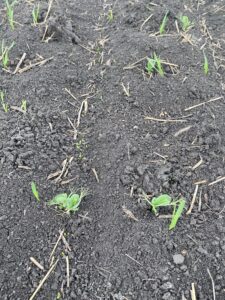
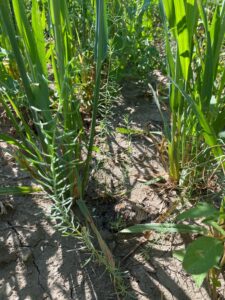
The Comstock, MN, site was replanted for both Experiment 1 and Experiment 2 on June 24. During the following 2 week period, another heavy rain event occurred and resulted in washing/crusting of soil, which resulted in almost no plant stand for both the perennial flax and also many of the intercrops in Experiment 2. Sowing depth was between 0.5 and 0.75 inches deep for all the plantings to this point. We hypothesized that sowing depth, combined with poor soil conditions due to crusting, was preventing stand establishment, and that, perhaps, having a nurse crop in the same planting furrow may help emergence when crusts develop. We decided to investigate this further with another experiment at Prosper, ND (near Fargo), which we planted on August 6, 2020. The study design incorporated a factorial combination of the following treatments: 4 seeding densities of perennial flax (2x, 4x, 6x, and 8x the seed production rate on the NRCS guide sheet), 4 intercrops (none, annual flax, natto soybean, and hard red spring wheat), and 5 planting treatments (surface-no packing, surface-packed, 1/3" deep, 2/3" deep, and 1" deep). In addition, half of each plot was left to heavy precipitation, which occurred naturally, while the other half had the soil loosened slightly after crusting with a Garden Weasel. This was an unreplicated preliminary experiment to determine if any of the treatments would show any signs of efficacy. The only treatments to result in more than a few seedlings emerging were the surface-seeded plots (both packed and unpacked; Figure 4; Table 3). There was no benefit of intercropping in-furrow for any of the depth treatments. The conclusion we reached is that perennial flax, in its current form, is very susceptible to heavy rain events that have become common from late spring through summer in the Northern Plains region. Seedling vigor is, however, a logical target for plant breeding to solve.
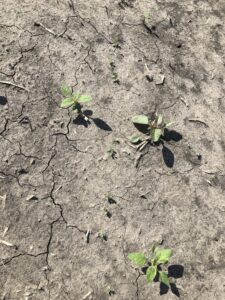
| Table 3. Surface seed with crusting / decrusted after rain (counted 9/2/20) | ||||
| # of seeds planted | ||||
| Treat | 100 (2x) | 200 (4x) | 300 (6x) | 400 (8x) |
| emerged seedlings | ||||
| No pack/weaseled | 9 | 10 | 16 | 29 |
| No pack/no weasel | 6 | 36 | 45 | 39 |
| Packed/weaseled | 4 | 8 | 4 | 8 |
| Packed/no weasel | 6 | 17 | 18 | 32 |
Our fall planting of the updated Experiment 1 (see updates in Methods) was conducted on 5 September 2020, after the spring wheat harvest window. Although not seeded into spring wheat stubble, we simulated what this planting window would be like in order to understand winter survival issues, if they arise. Learning from previous experiments, we reduced the seed depth to 1/8-1/4" deep and planted oats as nurse crop perpendicular to the direction of planting of the perennial flax (as was planned in the proposal). Rates of seeding were also increased to 4x and 6x, instead of the 1x, 2x, and 4x seed production rates initially proposed. As heavy rainfall is not typical in fall, and did not occur, we had excellent emergence and stand establishment. Consistent with observations in Carrington, the perennial flax tolerated the oat cover well, and the oat established well enough to provide a "snow catch" to maintain winter cover (Figure 5). Experiment 1 was only planted at Comstock, MN, for fall sowing date because Carrington, ND, was still too droughty for emergence of shallow-seeded crops. Because of the lack of success of spring/summer planting, due to commonly experienced heavy rain events, we added a treatment of "dormant seeding," which was planted 5 November 2020 at Comstock and 6 November 2020 at Absaraka, ND (in lieu of Carrington because of COVID related travel restrictions and drought; Figure 6). This followed the methodology originally outlined for Experiment 1, except planting depth was 1/8-1/4", planted into fall-planted oat companion crop, at 4x and 6x seed production recommended rate. The soil was cold at both sites at the time of planting, and prior to the first persistent snowfall, both fields were confirmed to have no sprouted seeds.
Figure 5. Fall planted (5 Sept. 2020) Lewis flax variety 'Maple Grove'. (L to R) 10/17/20, 03/27/21, 05/08/21, 05/30/21, and 07/11/21, Comstock, MN.
Figure 6. Dormant seeded (5 Nov. 2020) Lewis flax variety 'Maple Grove'. (left) emergence on 04/17/21, (right) progress on 05/30/21: dormant seeding left side, fall seeding right side, Comstock, MN.
As can be seen in Figures 5 and 6, fall and dormant seeding resulted in high emergence rates, almost zero overwinter death for fall seeding, very early spring seed emergence (before weeds) for dormant seeding, and comparable stands and vigor for both planting schemes by early summer. Our assessment is planting in early fall, dormant seeding, or an early spring planting before heavy rains are likely to occur, are good options for establishing perennial flax seedlings. We recommend a small grain companion crop to minimize winter exposure for seedlings.
The results of the trial in 2022 was as follows. The perennial flax never fully canopied due to the typically low level of leaf material on the plants (Figure 7 - left and right). There was no lodging in any plots. Days to bloom were identical for all plots. Plant height was on average 6 inches taller at the 4X planting rate than the 6X planting rate (81.8 vs. 75.5 inches, respectively), with no significant differences based on row spacing or date of seeding. Flax seed yield and oil content on the mature stands in 2022 was similar between fall or dormant seeding timings. Flax yield and oil content was also not influenced by seeding density. Flax yield did not significantly differ between the 15" vs. 30" row spacings (51 vs. 57 lb/acre, respectively), but oil content of the seeds was significantly different (33.0 % oil in 15" rows vs. 32.2 % in 30" rows; F=15.5; p=0.0013). The average yield across all treatments was approximately 52.6 lb/acre, which is substantially below the average yield for annual flax which ranged from 672 to 1,595 lb/acre in North Dakota in 2020. However, we did have substantial losses due to flax boll shattering that left the seed on the soil between windrowing (Figure 7 - bottom) and combining. In our breeding work, we are already working towards more determinant flowering and reduction of boll shattering to increase harvestable yield (see below). We believe that eliminating this major problem is achievable with breeding in a short period of time. Low yield may also be due to lack of fertility; however, according to soil tests, residual N should have been adequate. Substantial weed pressure at both sites, being organic sites with heavy grass and broadleaf weed seed banks, likely reduced yield as well.
Figure 7. (left and right) Extent of canopy cover from near-mature Maple Grove flax: 30" row spacing and 15" row spacing, respectively. (bottom) Windowing of perennial flax at the beginning of the first boll shatter (7 July 2022). Maple Grove is indeterminate, so this point was chosen for windrow to minimize seed loss and maximize mature seed set.
For Experiment 2, our initial failure to get excellent perennial companion crops established with Lewis flax led us to attempting other methods of weed control (see updated Methods). We first looked at flame weeding treatments on plants in the greenhouse. Three growth stages of perennial flax were flame-treated alongside a broadleaf (kochia, Bassia scoparia) and a grass (wild proso millet, Panicum miliaceum) weed species. The three growth stages of flax ranged in relative maturity with the youngest stage being seed germinating below the soil surface and oldest stage being flax with multiple true leaves. We noted good weed control in the greenhouse trial, especially among the broadleaf weeds. Perennial flax suffered high injury and mortality among the older two stages (75-85% mortality), while the youngest stage was minimally if at all affected by flame weeding (Figure 8). Older stage flax that survived flame weeding show a marked recovery response, initiating new growth within 7-14 days. Given these results, we determined that flame weeding in the field could potentially be effective if we could get the timing right. Additionally, we suspected that flax injured by flaming in the field may exhibit a stronger recovery response as they would not be limited in rooting depth and would have had a longer time to establish and recover.
Figure 8. (Left subfigure) Lewis flax, wild Proso millet and Kochia (L to R) 14 days after a 1x flame weeding dose (front), untreated flax and weeds (right rear). (Right subfigure). Mean percentage mortality for flax treated with flame weeding at different growth stages in the greenhouse study. Lowercase letters denote mean separation (α=0.05).
The Absaraka field site was treated with flame weeding first on 18 May 2021. We treated the plots in the evening so as to avoid morning dew, which can reduce the efficacy of flame weeding. Unfortunately, the flax had emerged well before any weeds. This was the first time we had dormant seeded perennial flax, and we did not have a precise baseline for estimating emergence time. Flax was approximately 7-10 cm tall with multiple true leaves at the time of flaming. This was not ideal, as we experienced high mortality at this growth stage in the initial greenhouse trials. We still applied the treatments as we hypothesized that flax in the field may be more resilient to flame weeding injury, and that the result may differ from the greenhouse trial as we were using a more precise piece of equipment.
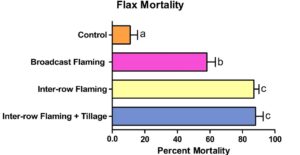
Following our initial flaming application at the Absaraka site, we noted 60-90% flax mortality (Figure 9). Unfortunately, we did not see lasting weed suppression from the initial flaming event. Existing weeds at the time of flaming were moderately reduced, however a second flush of new weeds emerged shortly after flaming, rendering the effort insignificant for thorough weed control. The intense drought conditions of summer 2021 likely compounded the injury to flax and impeded recovery. We determined that a second flaming application would likely totally eliminate flax from the field, so we decided to not flame at the Comstock site.
Given this unfortunate early result, we adjusted our approach to incorporate a new spread of flaming and tillage combination treatments on extra plots that had received no prior treatment. These additional plots were seeded at the same timing, spacing, and rate as the previously treated plots. We evaluated additional methods of mechanical weed management for these treatments, as well as scaling down our flame weeding to the use of a handheld light duty flamer for a more targeted application (Table 4). This second treatment scheme represents a more intensive, modified approach to using flame weeding with extra emphasis on reducing flax injury by reducing flax exposure to flame. These treatments were applied at both the Comstock and Absaraka sites during late August, after a flush of winter annual weeds (e.g., field pennycress) had emerged and established. Initial observational data supports good control of winter annual weeds and little to no flax mortality (Figure 10).
| Table 4. The third set of treatment combinations used to evaluate weed control efficacy in Lewis flax stands. Treatments were applied at the Absaraka, ND and Comstock, MN sites. | ||||
| Treatment number | Replicates per site | Early season action | Mid-season action | Late season action |
| 1 | 4 | Inter-row chisel plowing | Sickle-bar mowing | N/A |
| 2 | 4 | Inter-row chisel plowing | Mowing + Sickle-bar mowing | Inter-row rotary hoe tillage |
| 3 | 4 | Inter-row chisel plowing | Mowing + Sickle-bar mowing | Inter-row hand flame weeding |
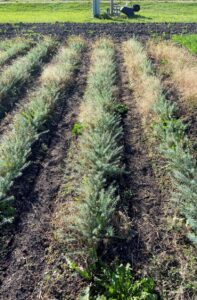
Despite the difficulties faced in the first year of utilizing flame weeding in perennial flax, we feel that there is still an optimal way to incorporate flame weeding as part of an integrated weed management plan for the crop. We believe that second year perennial flax may be more resilient to flaming injury.
We also began establishment of a fall seeded plot of perennial flax inter-cropped with winter wheat to begin exploring this approach to weed management as well (see updated 2 in Methods). Emergence of fall seeded portions of the experiment were successful (Figure 11 - top). Winter wheat formed a competitive canopy that nearly eliminated annual weed pressure throughout the growing season and even postharvest (Figure 11 -bottom). Winter wheat mean yield differed between sites, with 36.8 bu/acre at Comstock and 89.5 bu/acre at Absaraka, indicating that the wheat may have been more competitive at Absaraka. Mean winter wheat yield did not differ between the full vs. 2/3 wheat seeding rates. Flax stand density did not differ between sites or winter wheat rates, but the 1X flax seeding rate produced less dense flax stands than the 2X rate (2.3 vs. 4.9 flax plants/meter, respectively), suggesting that increased seeding rates may be needed with a companion cropping strategy. At Absaraka, most of the established Lewis flax was found at the beginnings and ends of the planting rows, which indicates that the winter wheat competition may have been a little too intense, but at Comstock, both rates (i.e., 1X and 2X rates) emerged and established more uniform rows of Lewis flax (i.e., no edge effect) but the overall flax density was relatively low. Reducing the winter wheat seeding rate further, e.g., to a half-rate, could improve flax establishment but also increase the risk of competitive annual weed establishment. Although more work remains to test other potential winter annual or annual crops as companion crops that produce harvestable yields and inhibit weeds without significantly inhibiting perennial flax establishment, these early results suggest that such as strategy could be developed.
Figure 11. (top panel) Fall planted winter wheat and Lewis flax planted 24 Sept. 2021. Successful stand establishment as of date of photo (5 November 2021). (left panel) 'Noreen' winter wheat interseeded with 'Maple Grove' perennial flax, near winter wheat maturity (27 June 2022). Weedy check adjacent. (right panel) 'Maple Grove' perennial flax successfully established after winter wheat harvest, 2 November 2022).
Objective 2: Enhance our perennial flax breeding program by learning from producer experiences in participatory, on-farm trials
As a result of weather and Covid-related limitations to the research, we have condensed Experiment 3 and 4 into a common experiment. As stated previously, we had planned to conduct a fall nursery planting of perennial flax in 2019, but weather conditions that resulted in delays for our farmer-cooperator led us to abandon those plans in favor of starting greenhouse plants for Experiment 4 -- development of inbred progenies for breeding and evaluation. During the greenhouse work, in March of 2020, our efforts ran into two issues, the development of the Covid pandemic and the diagnosis of the breeding research specialist (funded in part by this grant) with cancer. The research specialist took a leave of absence while obtaining treatment (which was successful and he returned to work in 2022). In order to work through these issues, we went from a full plot evaluation approach to a spaced plant evaluation that also included production of self pollinations and crosses, essentially combining the objectives (Figure 12). We also developed a working relationship with Noreen Thomas, a farmer that is closer to Fargo, which allowed us to do more of the breeding work with less travel, and this allowed us to more easily be Covid-protocol compliant. Additional accessions have been added to the trial site in 2021, doubling the number of accessions we planned to assess (to 200) and doubling the geographic area of our collections to also include high elevation types from Colorado and New Mexico (Figure 13). Data indicates a wide variety in seed morphology, plant height, growth habit, flowering time and duration, and vigor among the accessions that were evaluated. Efficient self-pollination protocols for the greenhouse have been developed, and progeny of these accessions are being grown in the greenhouse and field nurseries to continue the work of self-pollination to make uniform lines from these accessions for later release.
Figure 12. (L) Spaced plant nursery of perennial flax shortly after transplanting of seedlings. This was conducted on Doubting Thomas Farms, with participating farmer Noreen Thomas. (R) Brent Hulke and Noreen Thomas posing with a "picture frame" that we plan to set out in the field for visitors to take photos with the blooming perennial flax nursery.
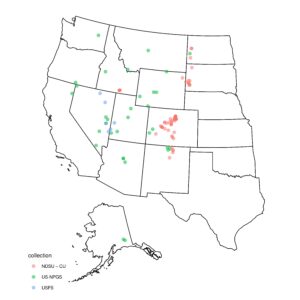
Through our spaced plant nurseries, we have been able to identify wild collections and partially inbred lines with traits important for continued domestication. Autonomously self pollinating types have been discovered from Colorado and North Dakota plant collections. Types with determinate habit have been found in high elevation collections from Colorado. Determinate habit is very important for ensuring that all the seeds mature at the same time, reducing shattering losses during harvest. Seed size differences are considerable between accessions, with larger seeded types arising from collections from the southern US. Larger seed size is a domestication trait that is associated with improved seedling vigor and increased oil content. Flower size variation is also considerable, from around 2 to 4 cm in diameter. Flower color variation includes white flowers and light blue flowers, with and without the presence of anthocyanin (red pigment) in the veins towards the center of the flower. While floral traits seem to be of minimal consequence in variety development, they can be quite useful for establishing distinctions between varieties, which may be useful for breeders in the future. The next steps for continued domestication are to develop knowledge of the inheritance of these traits and begin to put them together in a common variety, which will continue in the years after this project is completed. Even so, we are advancing lines with improvements over Maple Grove for near-term use and possible release.
Our agronomy experiments and previous science in domestication have indicated that increasing seed size in order to increase seedling vigor is possible and necessary to improve seedling emergence under challenging soil conditions like crusting. However, at the present time, planting very early or very late in the season also works for this hardy perennial plant. The extent of seedling tolerance to freezing conditions, however, is unknown. Graduate student Andre Gossweiler completed a freezing tolerance study in which 45 accessions from a cross-section of the native range (latitude, longitude, and elevation, Figure 14) were assessed for survival and vigor after a day-long deep freeze at several temperature points below freezing. Each plant was only exposed to one of the final freezing temperatures, and in doing so, we could see the response (in immediate death and also in survivor recovery vigor) of each accession as temperature treatments became colder. The resulting plants appeared similar to Figure 14-top two weeks after freezing. There were four accessions with 100% survival at the lowest exposed soil and air final temperature of 5 F. These included accessions from Alaska, western North Dakota, and very dry, high elevation conditions in Colorado. The lowest daily average soil temperature recorded by local weather stations in Fargo, ND, is 5 Fahrenheit, with lowest hourly of about 0 Fahrenheit. In the same experiment, the released variety Maple Grove ranked in the lower 50% for survival, despite overwintering very well as seedling and adult plants in the Fargo area fields. Our results suggest that seedling freezing tolerance could be easily improved in new varieties and enhancing freezing tolerance by breeding may be a worthy goal to ensure long term persistence, although the perennial Lewis flax already has excellent survival characteristics, on average. This work was submitted for publication to Annals of Botany-Plants and is currently being revised on the advice of peer scientists. The final paper is expected to be published as an open access article in Annals of Botany-Plants in early 2024.
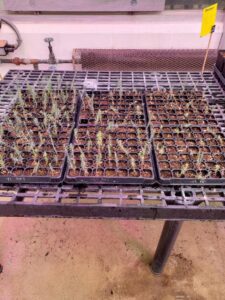
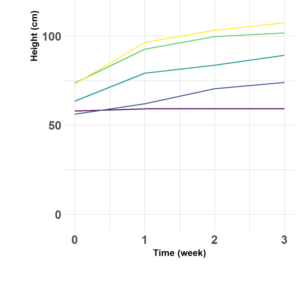
Figure 14. (top) Results of freezing tolerance tests of 45 Lewis flax collections representing the full range in latitude, longitude, and elevation of collection site (L to R) soil and air temperature of 15 F, 10 F, and 5 F. (bottom) Regrowth vigor of the Maple Grove variety over three weeks after freezing at equal temperature increments from 27 degrees F (yellow line) to 5 degrees F (purple line). The flat line at 5 F indicates no regrowth because of plant death. Most accessions possessed better freeze tolerance than Maple Grove.
During the height of the pandemic, we learned of plant collection and characterization work that was unpublished by Tom Jones, USDA-ARS, Logan, UT, and Stan Kitchen, USDA-NRCS, Ephraim, UT. They have collected wild perennial flax from the intermountain west and evaluated it for traits of interest for disturbance restoration plantings. These data were used to release the 'Maple Grove' variety, but were otherwise unpublished. Andre Gossweiler, a graduate student on this project, and Peter Innes, a graduate student of a collaborator at University of Colorado-Boulder, analyzed the data and wrote a peer-reviewed publication summarizing their findings, which also have importance for agriculture. Andre also contributed oil content and composition data of the samples from the Utah common garden experiment. The results provided a lot of useful information on trait correlations that will benefit increasing seed size and oil content by breeding, as well as altering plant architecture to be favorable for cultivation. This manuscript has been published in Annals of Botany-Plants, a scientific journal with a high impact factor rating of 3.276.
Compared to when we began breeding work on Lewis flax, we have a fuller appreciation of the domestication traits that need to be included in Lewis flax varieties for seed harvest. As a final, but important, part of our breeding activities, we needed to develop a reference genome sequence of Lewis flax in order to permit genetics studies and marker-assisted breeding. This will allow for more rapid breeding of domestication traits (reduced boll shattering, determinate habit, improved autonomous selfing, etc.) by defining DNA-based markers for the traits that can be scored at any time in the life of a plant. This reference sequence publication is now available as a pre-print, and the data are available in public archives.
Outreach: While Covid has certainly limited the opportunities for outreach, our partnership with Noreen Thomas has been helpful for informing the public about our work, through her great network and her abilities as an educator. Noreen had many visitors to her farm during the project, even during Covid, and has facilitated tours of our perennial flax nursery with researchers/students from the University of Minnesota, Iowa State University, and elsewhere; other farmers with a summer farm tour event; interested members of the public; and even a virtual tour with New York City chef Dan Barber, which is turning into a new collaboration on the food aspects of perennial flax in collaboration with Stone Barns in upstate New York. We spoke to a large group (~200 individuals) at North Dakota State University’s Dale E. Herman Research Arboretum annual field day located near Absaraka, ND. We were invited to present our yearly results at the Northern Plains Sustainable Ag Society conference in Fargo, each year. Some of our preliminary results were shared at the virtual American Society of Agronomy annual meeting in November 2020 and live American Society of Agronomy meetings in Salt Lake City, UT, in 2021 and Baltimore, MD, in 2022. In addition, although short-handed because of Covid and other health crises in our group, we have been able to produce two YouTube videos on perennial flax, one within our group and one with the assistance of NDSU extension. We plan to continue tours at perennial flax field sites in the future.
Our presentations at field days and other public events and conferences focused on the background, scope, and progress of our work with perennial flax. Audience members included neighbors, farmers (organic and conventional), students, and professors. Engagement from audiences was very high. Audience questions focused primarily on the economics of perennial flax production with a particular interest in yield potential and markets. The overwhelming response we receive indicates considerable interest in perennial Lewis flax for cultivation. Producers are encouraged by our research in organic weed control and the agronomic implications of perennial flax cultivation. End users are interested in the fatty acid composition of the seed as an important source of omega-3-rich vegetable oil and seed products.
Lewis flax (Linum lewisii Pursh) has the potential to be a new perennial, oilseed crop that could simultaneously meet oilseed production, ecosystem service, and farm resiliency goals. This study is a first step toward developing agronomic and breeding strategies for Lewis flax. We learned the following:
- Shallow seeding (1/4" deep or less) in the fall, early winter (dormant), or early spring is necessary to avoid soil movement from heavy rain events. Winter cover from previous crop chaff or a cover crop is helpful to protect seedlings over winter.
- Lewis flax is much more freeze tolerant than previously believed, and determined by genetics. This allowed the fall and early spring planting dates to be more successful than we initially believed they would be.
- Weed control is more difficult than expected because of a natural lack of canopy development, even under ideal stand density. Use of cover crops and companion crops (at seedling stage) have shown some success, but additional experimentation is required to optimize a weed control system. This is the subject of a USDA-AFRI proposal that is now in review.
- Broadcast flame weeding has not shown significant promise as a weed control method, but flame weeding could be useful if band-applied with proper shielding on older plants. It may also be paired with tillage for more success.
- Soil fertility was not addressed as a treatment in our experiments, but will be a subject of investigation if our USDA-AFRI proposal is funded.
- Combine harvesting is straightforward with a two-pass system (windrowing followed by combining with a pickup header).
- We doubled the number of wild plant specimens that we intended to collect, and this has provided interesting and useful variation for our breeding program. We are currently in excellent shape for genetic resources.
- Breeding needs to continue to focus on domestication traits like reduced seed shattering, more determinate blooming, autonomous self-seed production, increased seed size, and seedling vigor, in addition to yield. Oil contents are close to annual flax, but could be improved by breeding. The fatty acid composition of Lewis flax is similar to annual flax. So while some trait targets, surprisingly, do not need significant improvement, additional targets were found as a part of our agronomy and breeding work. We will continue to improve these traits using breeding support from USDA-ARS.
Continued improvements in management and genetics of Lewis flax, as well as human community awareness, will be critical to its successful development as an agronomic crop. This project has allowed us to develop a solid foundation for that goal.
Education
Two M.S. students were involved with this project, Zachary Pull and André Gossweiler. These students participated in all project experiments, and prepared thesis documents and peer-reviewed manuscripts. One has been published, and the other peer reviewed manuscript is in revision and likely to be published soon.
Zachary Pull is currently working for Syngenta in MN.
André Gossweiler recently graduated and is looking for a new opportunity in biological science.
In addition, three undergraduate students, Landon Johnson, Cassidy Voeltz and Rebekah Corson, conducted undergraduate research on perennial crops as part of this grant.
The work conducted as part of this grant has led to a new graduate student, Brady Koehler, working on Lewis flax breeding as a thesis topic (funded by USDA-ARS). Another graduate student, Joseph Barham, is working part time on Lewis flax genetics, as well.
Project Activities
Educational & Outreach Activities
Participation Summary:
In 2020, we had planned to present preliminary results at two NDSU field days, but both field days were cancelled because of the pandemic. Instead, the field days were held via YouTube. We presented our preliminary results via poster at one professional meeting that was held virtually, the 2020 ASA-CSSA-SSSA International Annual Meeting. Other outreach included an additional YouTube video we produced, information found on our lab website (hulkelab.org), a popular press article, and personal visits to plots of 180 consumers, 5 interested scientists from outside of the collaboration, 4 extension staff educators, 3 politicians (including Sen. Tina Smith's staff), and 1 chef / food advocate from New York City, who toured via zoom conference in the field, in addition to consulting with us thereafter.
In 2021, we had two in-person field days (one NDSU, one Doubting Thomas Farms), one presentation at the 2021 ASA-CSSA-SSSA meeting in Salt Lake City, several personal visits, another visit from Sen. Tina Smith's staff, continued discussions with Stone Barns and chef Dan Barber, and 7 interested scientists from outside the collaboration.
In 2022, we presented at the annual Northern Plains Sustainable Ag Society annual meeting and at the Agronomy Society of America meeting in Baltimore. We gave tours of research at the NDSU Carrington Field Day, for the Concordia College Environmental Science program, and for the Iowa State University Sustainable Agriculture summer tour course. We provided on-farm demonstrations for state extension educators, local university educators, congressional staff, new women farmers, and new American farmers.
In 2023, so far, we presented at the annual Northern Plains Sustainable Ag Society meeting. One in-person field day with Doubting Thomas Farms, where scientists presented, and two additional field days at Doubting Thomas Farms that was guided by Noreen Thomas.
Four peer reviewed journal articles were published as a result of this work. The full citations and links to open access articles are available below:
Gossweiler AD, Smart BC, and Hulke BS. Survival analysis of freezing stress in the North American native perennial flax, Linum lewisii Pursh. Annals of Botany-Plants (in revision).
Learning Outcomes
- Knowledge about the possibility of growing perennial flax as a new crop in the region.
Project Outcomes
not applicable - we anticipate farmer adoption will occur in future years with continued development of varieties and management know-how.
